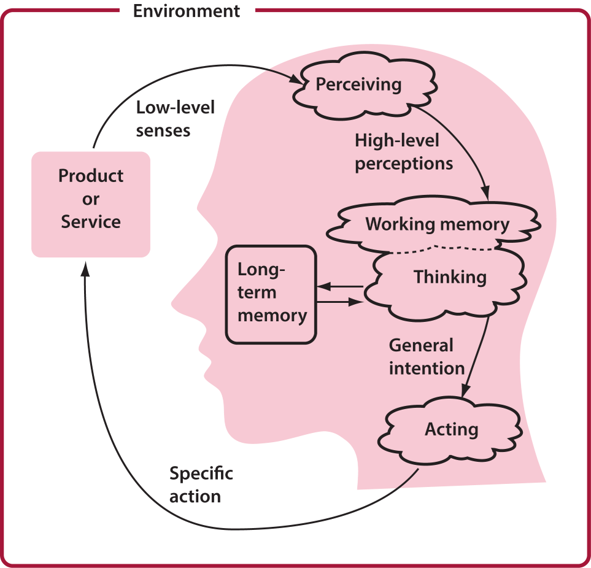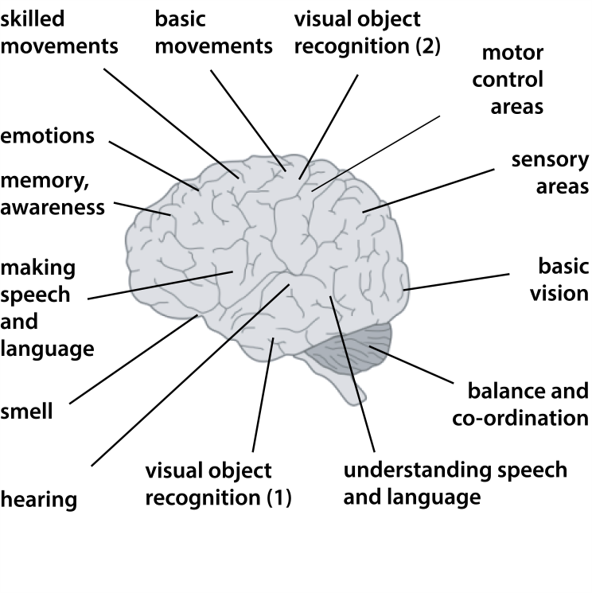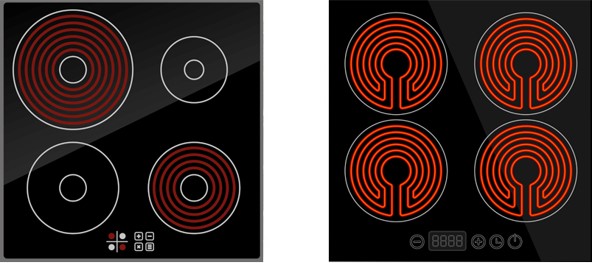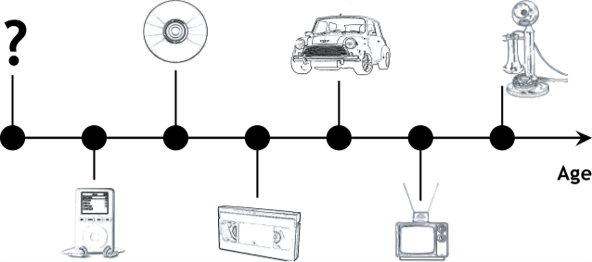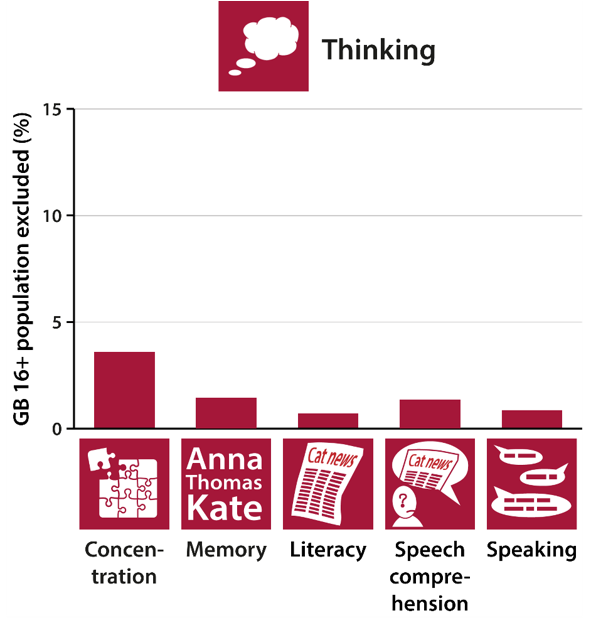Thinking, also known as ‘cognition’, refers to the ability to process information, hold attention, store and retrieve memories and select appropriate responses and actions. The ability to understand other people, and express oneself to others can also be categorised under thinking.
Thinking is essential for interacting with a product, as the user needs to process the information from the product interface and decide what to do. Many different aspects of thinking may be involved.
On this page:
Important note
This page highlights factors to consider when designing or assessing products, and provides some useful suggestions, but the advice should be followed within the context of an Inclusive design process.
Introduction
Many different aspects of thinking are involved in product interaction. These include processing the sensory information from an interface, keeping one’s attention focused on the product and task, remembering what the icons on the product mean, and selecting appropriate responses and actions.
These functions are affected to different extents by age. Well-established memories and skills are unaffected with age, whereas the time required to learn new things, make decisions and respond to sensory information increases, as can the frequency of errors. The ability to recognize patterns is also reduced, and there is an increased susceptibility to distraction, resulting in reduced capability for tasks that require two or more simultaneous functions.
Degenerative brain disorders are also more prevalent with age, examples of which include Parkinson’s and Alzheimer’s diseases. These affect memory, attention, movement, perception, reasoning and social interaction to varying degrees.
Layout and visual form
The visual form and layout of products, particularly their controls, can provide strong clues as to how they should be used. These clues were once called ‘affordances’ (Norman, 1998), but more recently the term ‘signifiers’ has been found more useful within interface design. For example, a flat plate on a door signifies that it should be pushed, while a handle signifies that it should be pulled.
Interpreting visual form involves part of thinking called ‘visual thinking’. This is the ability to perceive and think about visual objects and spatial relationships. It includes the ability to relate objects to each other based on their shape, colour and position. Objects that are grouped by properties like these may be perceived as similar, and this can be used to help users identify and find controls.
The interpretation of visual form also relies on prior experience. For example, people’s general prior experience helps them to realise that buttons should be pushed and handles should be pulled.
Important things to consider in design are to:
- Indicate interaction methods. Use the visual form of a device to help users understand what areas they can interact with, and the correct way to interact with them.
- Group features visually. Use shapes, colours and alignment to assist in visual grouping of features that share some kind of similarity, thereby reducing the time and memory required to locate a desired feature. For example, buttons that share similar functions on a calculator are often designed so that they are perceived as part of the same visual group, thereby making the calculator easier to use.
- Match controls and devices. Make it clear how controls match the devices they affect, e.g. align controls in a spatial orientation that matches the layout of the corresponding devices.
- Use spatial controls consistently. Consider the increased demand on spatial ability if left and right are used to represent up and down (or vice versa), and avoid this situation wherever possible.
- Match prior experience. Use controls in ways that match general prior experience. For example, our general prior experience indicates that handles should be pulled. Providing a handle that should be pushed can cause confusion.
Further information
Norman (1998)’s book: ‘The Design of Everyday Things’ explains more about affordances. (Published by MIT).
The shape and form of this door handle indicates that it should be pulled downwards but the door actually opens sideways. The handle does not help the user understand how it should be used.
Language and communication
Many products rely on the user’s language and communication abilities to understand information in the form of text, graphics or speech or to enter information into an interface.
However, language and communication abilities are complex, involving many different underlying abilities, including perception, attention, memory and high-level thinking.
Many different conditions can interfere with language and communication. These include specific difficulties with written language such as dyslexia, and more general problems with thinking such as memory and attention difficulties. Sensory loss can also make it difficult to perceive information, and motor difficulties may make it difficult to speak clearly, type or write.
Important things to consider in design are to:
- Use simple language. Information on simple language is available from The Plain English Campaign website. This includes free guides on how to write clearly.
- Supplement textual information. Images and icons can supplement text and help the user to understand it better.
- Take care with speech input. If using speech input, consider that spoken language may be indistinct. Do not require users to have clear, precise speech.
- Consider dyslexia. Consider the needs of people with dyslexia. This is a specific learning difficulty affecting language skills, which affects around 4% of the population severely (see the British Dyslexia Association’s website). Simple design changes can make text more accessible to people with dyslexia. Specific design guidelines are available from the ux Movement website and the Dyslexia friendly style guide from the British Dyslexia Association.
Attention and concentration
A person’s attention can be consciously directed towards specific tasks, or it can be grabbed by a distracting event such as a flashing light or the sound of one’s name. This can be advantageous, e.g. to direct a person’s attention towards a warning or an impending hazard. Alternatively, it can be a distraction, e.g. if a flashing light takes one’s attention away from the task at hand.
A person’s attention can be overloaded if too many things have to be kept in mind at once. This may result in items or tasks being forgotten. For example, if a person attempts to cook while having a conversation or reading, it is likely that something will be forgotten or an action will be missed.
Time pressures can also overload the user’s resources. For example, when driving a car, users need to continually process incoming sensory information in the form of road hazards, signs, and information from the vehicle. If users cannot process and respond to the incoming information fast enough, then newly arriving information passes unnoticed, or existing information is lost.
The ability to maintain attention decreases with increasing age, resulting in reduced capability for tasks that require two or more simultaneous functions.
Important things to consider in design are to:
- Avoid multiple focuses of attention. Try to ensure that attention is only required to be directed to one place at any one time.
- Avoid unnecessary elements. Avoid unnecessary elements on an interface, especially items that are flashing or eye-catching, as these may distract from the main task.
- Avoid time pressurised tasks. Be wary of potential problems that can result if multiple actions have to be completed within a certain time period.
Structuring information
Some products and services require the user to attend to and remember information. For example, the user may have to remember a sequence of actions to perform in a computer application, which number to press from a list of options in a call-centre menu, or where a particular option is in a hierarchical menu structure. This involves an aspect of thinking known as ‘working memory’.
Working memory can be thought of as a rough working area for items being considered. Examples of its use include remembering a phone number that’s being read out, a list of words in a drop-down menu, or where the objects on a table are in relation to each other.
The capacity of working memory is known to be limited to around seven ‘chunks’ or items. However, the amount of information that can actually be simultaneously stored and processed depends on the form of the information, the way in which it is chunked together, and how the present information links with stored memories.
Important things to consider in design are to:
- Structure information. Structure information to assist memory and learning. Appropriately structured information can be processed as ‘chunks’ rather than individual items.
- Reduce memory load. Reduce the number of information chunks that need to be kept in mind at any given time, and try not to exceed five as the best practice.
Interface navigation and nested menus
The way in which the navigation of an interface is structured is related to the structuring of information, and has similar issues.
Nested menus are commonly used to structure both information and the navigation of a computer application or website. Using such a menu involves processing the items in the menu on the current level, as well as remembering where you are within the menu structure as a whole.
Complex navigation and menu structures can cause users to become lost, but there are several things designers can do to help:
- Make actions reversible. Try to ensure that all actions are easily and immediately reversible, and try to constrain the availability of actions that would result in undesirable or irreversible outcomes.
- Provide a ‘back’ button. Provide an obvious mechanism that allows users to get back to their previous location or home when navigating a menu structure.
- Avoid unseen menu items. Consider the memory implication of unseen content if scrolling is required to obtain more menu items.
- Keep menus consistent. Assist learning and recall through distinctive spatial positions for menu options and be wary of the potential confusion if these positions change.
- Avoid deep hierarchies. Where hierarchy is used, ensure that the current location within the overall hierarchy is always evident and try not to exceed three levels.
Learning and prior experience
Long-term memory is important in learning and remembering how to use a product. Long-term memories require learning and repetition to become fixed, but once stored they can last a long time and be retrieved by triggers or cues.
Remembering something takes two main forms: recognition and recall. Recognition involves identifying something, e.g. identifying whether you have seen someone’s face before, or picking the right option from a list. Recall, on the other hand, involves remembering something from a set of cues that are distinct from the item itself, e.g. remembering someone’s name when you see their face, or remembering what to type into an interface without being told what the possible options are. In general, recall is harder and takes longer.
Prior experience, as well as specific memories, is relevant to product use. For example, our general prior experience helps us to realise that buttons should be pushed, and handles should be pulled. It also enables us to recognise interface elements that are common across multiple products, such as common icons and interaction paradigms. More specific experience with a product makes that particular product easier to use in the future.
The ability to use a new product is strongly dependent on how well it matches these specific and general experiences. Our ability to learn decreases with age, so a product is likely to be difficult to use for an older person if it does not match up with their experiences when younger. Initial interaction with an unfamiliar product is characterised by frequent errors but this can improve if the product supports learning through feedback.
Important things to consider in design are to:
- Assist recognition. Use recognition rather than recall, where possible, to help users remember actions and options.
- Use elements consistently. Be wary about using common interface elements in unexpected ways, as that can confuse users.
- Expect different prior experiences. Avoid relying on familiarity with more recent interface elements and styles. Be aware that users’ prior experience will differ from your own.
- Give feedback. Support learning by ensuring that all possible actions generate suitable feedback that guides the user.
Our prior experience helps us to understand that this slider should be pushed up to increase the volume. It also enables us to understand the icons on this remote control.
Population statistics
The graph on the right shows the proportion of the British adult population living in private households who would be excluded by tasks with the following levels of thinking demand. Note that these demands refer to different types of thinking capability and so are not in increasing order of difficulty.
- Concentration: Concentrate enough to run a bath without getting distracted
- Memory: Remember the names of friends and family whom you see regularly
- Literacy: Read and understand a short newspaper article, e.g. in a tabloid newspaper
- Speech comprehension: Understand a short audio news report
- Speaking: Speak clearly enough that others understand you in typical everyday conversations
This graph was derived from the Disability Follow-Up to the 1996/97 Family Resources Survey, see the page on Assessing demand and exclusion for details. At the time of the survey, the GB adult population living in private households was 43.3 million.
Further information
Statistics on the numbers of people in Great Britain with different levels of thinking capability can be found by using the Exclusion Calculator at calc.inclusivedesigntoolkit.com.
More information on thinking can be found in the following sources:
- The Mayo Clinic’s website provides information on Dementia, and Alzheimer’s Disease.
- Information on speech and language impairments can be found on the Afasic website.
- Harley T (2001). The Psychology of Language: From Data to Theory. Psychology press, Hove, UK provides more information on communication and language.
- Baddeley A (2004). Your memory, A user’s guide. Carlton books.
- Wickens CD, Hollands JG (2000). Engineering psychology and human performance, 3rd edition. Prentice-Hall, New Jersey, USA.
- Huppert FA (2002). Designing for Older Users, In: J Clarkson, R Coleman, S Keates and C Lebbon (Eds) Inclusive Design: Design for the whole population. Springer Verlag, London, UK, Chap.1, 30-49.
- Wickens CD, Hollands JG (2000). Engineering psychology and human performance, 3rd edition. Prentice-Hall, New Jersey, USA.
The context of use can also affect a person’s cognitive performance. This includes personal aspects such as mood and motivation, and environmental aspects such as peer group and distraction.
The page on digital personas highlights some of the factors that affect digital exclusion, in a way that is easy for designers to engage with.
Feedback
We would welcome your feedback on this page:
Privacy policy. If your feedback comments warrant follow-up communication, we will send you an email using the details you have provided. Feedback comments are anonymized and then stored on our file server. If you select the option to receive or contribute to the news bulletin, we will store your name and email address on our file server for the purposes of managing your subscription. You can unsubscribe and have your details deleted at any time, by using our Unsubscribe form. If you select the option to receive an activation code, we will store your name and email address on our fileserver indefinitely. This information will only be used to contact you for the specific purpose that you have indicated; it will not be shared. We use this personal information with your consent, which you can withdraw at any time.
Read more about how we use your personal data. Any e-mails that are sent or received are stored on our mail server for up to 24 months.


